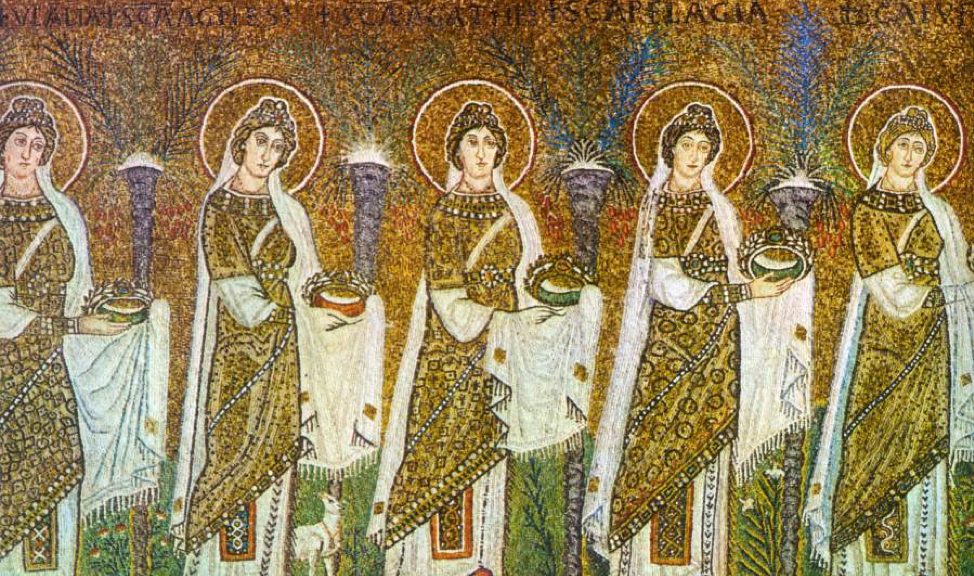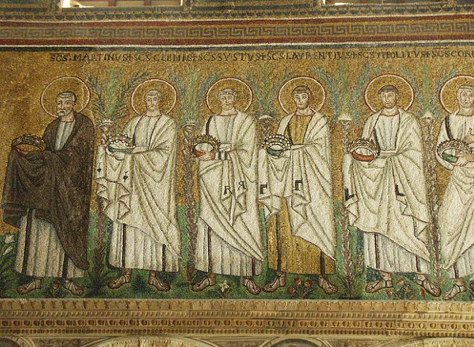
Historic Women of Faith: Three Female Martyrs in Ravenna’s Ancient Mosaics
Introduction
In June 2019, I enjoyed the amazing opportunity to travel to northern Italy for an immersive study of medieval women’s spirituality and theology. Led by Sandra Glahn, Professor of Media Arts and Worship, my fellow students and I stayed in monasteries and visited art and history museums, cathedrals, and catacombs. One of my favorite excursions was to Ravenna, the Western Roman Empire’s capital in the fifth century and later (6th–8th century) of Ostrogothic and Byzantine Italy. Best known for its early Christian mosaic art, it has eight UNESCO world heritage sites. The great Italian poet Dante Alighieri described Ravenna’s Byzantine mosaics as “the sweet color of Oriental sapphires.” In this second of my “Historic Women of Faith” series, I will introduce you to three female martyrs in Ravenna’s ancient mosaics.
Basilica of Sant’Apollinare Nuovo
These three martyrs are among twenty-two women martyr’s featured in the Basilica of Sant’Apollinare Nuovo. Early in the sixth century, King Theodoric the Great commissioned this large chapel for his Ravenna palace. The Basilica of Sant’Apollinare Nuovo was dedicated in 504 A.D. to “Christ the Redeemer.” It was originally an Arian church. After the Byzantines conquered Ravenna in 540, they converted it to an Orthodox church for the Catholic faith. Archbishop Agnello (556–579) eradicated all traces of Arianism in the church’s decorative art. He changed the mosaics in the Basilica’s apse (altar area). And he decorated the nave walls (the central part of the church) with mosaic processions of martyrs: twenty-two female martyrs on the north nave wall and twenty-six male martyrs on the south nave wall.[1]
Mosaics of Martyrs
Along the north nave wall, high above arches supported by ancient columns with Corinthian capitals, an uninterrupted and majestic mosaic parade of martyrs—twenty-two haloed women shines against a golden sky. In a veiled hand, each carries a crown. Each figure is adorned similarly in asymmetrical, embroidered robes, with their red stocking feet (or perhaps soft, red slippers) resting on tufted emerald grass. Their heads are inclined forward. Flowering palms, small flowers, some roses, and lilies, as well as one little lamb, can be seen interposed among the figures. The martyr’s Latin name appears above their head.

Three red-capped magi (or kings), each cloaked in sumptuous clothing, lead the female martyrs out from the city of Classe. The magi carry gifts in unique containers. Above the three, an eight-pointed star seemingly points them forward. The martyrs and the magi are proceeding toward Christ (depicted as a grown man) on the Virgin Mary’s lap. Seated on a tall, jeweled throne, Mary and Jesus are surrounded by four angels, two on either side. Some describe this mosaic presentation as a “procession of the Holy Virgins.”[2] But, not all of the women were unmarried.[3]

Along the south nave wall in the Basilica of Sant’Apollinare Nuovo is a procession of twenty-six male martyrs. Each of these haloed figures wears a white tunic and cloak and carries a gem-encrusted crown. Colorful flowers, white lilies, emerald grass, and slender palms against a gold sky adorn the background. One figure, St. Martin, wears a dark cloak. These martyrs proceed toward a mosaic of Christ, seated on a lyre-shaped, jeweled throne, and surrounded by four angels.

Remembering and Commemorating Martyrs
Roman and Justinian Martyrology record the martyr’s histories. They are organized by the date of their remembrance, known as a feast day. Martyrology is “the official and accredited record…the glorious deeds of the Soldiers of Christ in all ages of the Church; of the illustrious Heroes and Heroines of the Cross, whom her solemn verdict has beatified or canonized.”[4]
I researched the twenty-two women martyr’s in the Ravenna mosaics at the Basilica of Sant’Apollinare Nuovo. After transcribing their Latin names into English, I searched for their stories. Below are the brief accounts of three female martyrs in Ravenna’s ancient mosaics: St. Agnes, St. Cecilia, and St. Anastasia. (At the end of this post, I’ve listed the names of all twenty-two female martyrs in the Basilica.)
St. Agnes
St. Agnes. Martyr, virgin. Feast day: January 21. As a child, Agnes committed herself to virginity to honor God. Described as beautiful and wealthy, multiple suitors pursued her. Her suitors arranged for her capture and threatened her with torture to persuade her to marry. But, she refused to recant. “Her chief accuser, whom frustration had driven to become vindictive, incited the judge against her.” By the swift stroke of the executioner’s sword,[5] she died,[6] at age thirteen[7]. Artistic depictions often show her with a lamb by her side. Agnes is “agne” in Greek, which means pure or chaste. The Latin word for lamb is “agnus.” She died in 157. Circulated widely was the belief that eight days after her death, Agnes appeared to her parents accompanied by a choir of virgins, with a lamb at her right side. Two churches, Sant’Agnese in the Piazza Navona and Sant’Agnese fuori le Mura, were dedicated to her. Augustine and Jerome, two of the early church fathers, commended her. And St. Ambrose wrote an early hymn dedicated to Agnes. (There was also a Roman St. Agnes, an older person, with a different feast day.)[8]
St. Cecilia
St. Cecily (or St. Cecilia). Martyr, virgin. Feast day: November 22. Born into a noble Roman and Christian family, Cecilia chose to take a chastity vow as a very young girl. However, her parents insisted that she marry Valerian, a wealthy young nobleman. She prayed for God to preserve her virginity, despite her marriage. And, sang in her heart, “Keep Thou my heart and my body immaculate, that I may not be confounded!”[9] After telling Valerian about her faith and vow, he converted to Christianity and was baptized on his wedding day.[10] Valerian and his brother Tiburtius “devoted themselves to burying the martyrs slain daily” by Turcius Almachius, the city’s prefect. They were arrested, tortured, and beheaded.[11] Cecilia preached and converted many to the faith. “She summoned 400 persons to her home, where Urban baptized them all.” Then she was arrested, with an attempt made to kill her by flames in her own home, but she escaped. Almachius then sent a soldier to behead her. Buried in the catacomb of St. Callistus, Pope Paschal I moved her relics…to a church dedicated to her, the Church of St. Cecilia.[12]
St. Anastasia
St. Anastasia. Martyr, widow. Feast day: December 25. Roman daughter of a nobleman “named Protasius, or Pretaxato” and his (secretly Christian) wife, “Fausta, or Flavia,”[13] Anastasia was raised in the faith, with the priest St. Chrysogonus acting as a spiritual director. After her mother died, Protasius forcibly married Anastasia to Publius, a non-believer. She did not disguise her dislike over her marriage, which angered Publius. Anastasia often disguised herself as a man and went, with her maid, to visit imprisoned Christians. Upon discovering these secret visits, her husband imprisoned her, along with three maids, and threatened to starve her. During this time, Chrysogonus encouraged her through letters to hold fast to faith despite her sufferings. She was released after her husband died.[14]
Different versions of Anastasia’s story diverge at this point. She seems to have traveled with Chrysogonus from Rome to Aquileia, Italy, to Macedonia, and Sirmium, Illyria. After Chrysogonus was beheaded, Anastasia was forced onto a sailing vessel with holes in it, along with other Christians, and set adrift per Diocletian’s orders.[15] But the voyage, instead of resulting in a shipwreck, miraculously landed on the island of Palmaria. However, authorities there ordered all the Christians to be killed because they refused to recant their faith. Two hundred and seventy were said to have been killed, with Anastasia being burned alive. [16] “The church of St. Anastasia, under the western corner of the Palatine, was at one time among the most important in Rome. Anastasia was “one of the most highly venerated saints of the church of Constantinople.”[17]
Female Martyrs Honored at the Eucharist
During the Canon of the Roman Mass (in the Catholic Church), martyr’s names are commemorated at the Eucharist (communion). “In the Roman Canon, only martyrs are named before and after the Consecration: this distinction is justly due them…by the bloody sacrifice of their life; they appear as the ripest and most glorious fruit of the Sacrifice of Christ…they offered the sacrifice of the world and of themselves—amid untold torments and sufferings. The virtues of fortitude and patience, of faith and of love which they practiced in a heroic degree shone resplendent in them.”[18]
This Mass names the Virgin Mary, male apostles, and saints, and seven female martyrs (each depicted in Ravenna’s Basilica of Sant’Apollinare Nuovo): St. Felicitas, St. Perpetua, St. Agatha, St. Lucy, St. Agnes, St. Cecilia, and St. Anastasia.[19] The three female martyrs in Ravenna’s ancient mosaics are among twenty-two female martyrs honored in the Basilica of Sant’Apollinare Nuovo. The other women who join the seven named in the Roman Mass are St. Anatolia, St. Christine, St. Crispina, St. Daria, St. Emerentian, St. Eugenia, St. Euphemia, St. Eulalia, St. Felicity, St. Justine, St. Paulina, St. Pelagia, St. Perpetua, St. Savina, St. Valerie, St. Vicenza, and St. Victoria.
Who shall separate us from the love of Christ? Shall trouble or hardship or persecution or famine or nakedness or danger or sword? As it is written: “For your sake, we face death all day long; we are considered as sheep to be slaughtered.” No, in all these things, we are more than conquerors through him who loved us (Rom 8:35–37).
This is the second post in my Historic Women of Faith series. Read the fascinating story of the twin Lady Bible Hunters in my first post here.
[1] Guido Marchetti, ed., Women in the Mosaics of Ravenna, Opera Di Religione Della Diocesi Di Ravenna, Ravenna.
[2] S. Apollinare Nuovo, (Rimini: Edizioni lito87), 23.
[3] Marchetti, Women in the Mosaics, 43.
[4] J. Cardinal Gibbons, “Introduction to the Roman Martyrology,” Roman Martyrology: The Complete Roman Martyrology in English for Daily Reflection, 1900. http://www.boston-catholic-journal.com/roman-martyrology-complete-in-english-for-daily-reflection.htm. Accessed 09–16–2019.
[5] John Foxe, “Martyrdom of St. Agnes,” The Book of Martyrs, (Liverpool: Nuttall, Fisher, Dixon, 1807), 174.
[6] Kristin E. White, A Guide to the Saints, (New York: Ballantine Books, 1991), 4.
[7] John Foxe, “Martyrdom of the Theban Legion,” The Book of Martyrs, (Liverpool: Nuttall, Fisher, & Dixon, 1807), 149.
[8] Carolyn Diskant Muir, “St. Agnes of Rome as a Bride of Christ: A Northern European Phenomenon,” Simiolus: Netherlands Quarterly for the History of Art, Vol 31, No. 3 (2004–2005), 134-155. Accessed 08–13–2019.
[9] Nicholas Gihr, “The Saints of the Canon of the Mass,” The Holy Sacrifice of the Mass, 1918, reprinted from The Catholic Voice, 18. https://www.sanctamissa.org/en/spirituality/saints-in-the-roman-canon.pdf.
[10] Marchetti, Women in the Mosaics, 51.
[11] Rosemary Ellen Guiley, The Encyclopedia of Saints, (New York: Facts on File, Inc., 2001),72.
[12] Guiley, The Encyclopedia of Saints, 72.
[13] Agnes B. C. Dunbar, A Dictionary of Saintly Women, Vol I, (London: George Bell & Sons, 1905), 53.
[14] Dunbar, A Dictionary of Saintly Women, Vol I, 54.
[15] Marchetti, Women in the Mosaics, 47.
[16] Dunbar, A Dictionary of Saintly Women, Vol I, 54.
[17] Phillip Barrows Whitehead, “The Church of S. Anastasia in Rome,” American Journal of Archaeology, Vol 31, No 4, (Archaeological Institute of America, Oct-Dec, 1927), 413. https://www-jstor-org.dts.idm.oclc.org/stable/pdf/497863.pdf?refreqid=excelsior%3A19640e7ae6a7117de05cd11e93993f03
[18] Nicholas Gihr, “The Saints of the Canon of the Mass,” The Holy Sacrifice of the Mass, 1918, reprinted from The Catholic Voice, 12. https://www.sanctamissa.org/en/spirituality/saints-in-the-roman-canon.pdf.
[19] Dunbar, A Dictionary of Saintly Women, Vol I, 53–54.